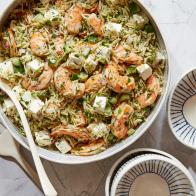This Diabetes Dietitian Wants You To Embrace Carbs and Your Culture
Mindfully eating carbs, especially those that hold cultural significance, can be part of a healthy, balanced diet. It’s also important for your physical, emotional and mental health.

Simon McGill/Getty Images
Over the past couple of decades, the term “healthy” as it relates to food has undergone significant transformations. Certain foods have been unfairly villainized, which makes eating overwhelming for someone trying to manage their diabetes. Carbohydrates, in particular, have been historically looked down upon in the U.S. nutrition scene. From the rise of low-carb diets to the demonization of specific carb-rich foods, such as corn and rice, many people have been left feeling confused about what they should eat. This stigma has especially impacted the perception of certain cultures’ foods, with dishes from diverse backgrounds often judged unfairly through the lens of mainstream American dietary trends.
As a dietitian specializing in diabetes counseling, I’ve witnessed firsthand the misguided belief that cutting out carbs is the key to improving blood sugar levels. It’s understandable to make drastic changes, especially for someone who has been newly diagnosed. However, the reality is that restricting entire food groups, particularly ones that hold cultural meaning, can lead to feelings of deprivation and disconnection. Culturally significant foods, whether they be tortillas from Mexico, chapatis from India or plantains from the Caribbean, are not only delicious but also offer valuable nutrients. By incorporating these foods in a balanced way, individuals with diabetes can enjoy a wide array of flavors while managing their condition effectively.
When it comes to navigating eating for people with diabetes, practical advice is key. For those whose food culture revolves around staples like rice or grains, it’s crucial to find a balanced approach that honors tradition while supporting health goals. Rather than viewing these foods as off-limits, consider incorporating them into your meals mindfully. Aim for a balanced plate where carbohydrates like rice or starchy carbs make up about 25 percent of your meal, with the remaining 50 percent is filled with non-starchy vegetables like greens, cabbage, eggplant and cauliflower. This approach not only helps to control blood sugar levels but also ensures you're getting a variety of nutrients on your plate.
The remaining 25 percent should consist of protein-rich foods such as lean meats, seafood and tofu. These foods can also help balance blood sugar levels and keep you feeling satisfied. Including these foods alongside your cultural staples can provide a well-rounded meal that supports overall health. Also, be sure not to leave out healthy fats, such as those found in avocados, nuts and olive oil, which can help to enhance the flavor and satiety of your meals. Here are some examples of what this can look like:

Matt Armendariz
Get the Recipe: Epis-Marinated Grilled Red Snapper
Grilled Red Snapper with Rosemary Roasted Potatoes and Vegetables: Start with a generous portion of Epis-Marinated Grilled Red Snapper, which is a good source of heart-healthy omega-3 fatty acids and protein. Round out the meal with a colorful array of these Rosemary Roasted Potatoes and your favorite vegetables, such as bell peppers, zucchini and onion, drizzled with a touch of olive oil for added flavor and healthy fats.
Mushroom Mapo Tofu with Smashed Cucumber Salad: For a plant-based option, opt for this Mushroom Mapo Tofu and serve with brown rice. Tofu provides a substantial source of protein, while brown rice offers complex carbohydrates and fiber. Pair with this refreshing cucumber salad for added satisfaction.
Jamaican Brown Stew Chicken with Boiled Cassava: Enjoy this Jamaican staple featuring stewed chicken as the main protein source. Serve it alongside boiled cassava (or plantains) and enjoy with your favorite green salad and avocado. This plate offers a balance of protein, complex carbohydrates and heart-healthy fats.
It’s important to remember that managing diabetes is not about deprivation or restriction. It’s about finding a balance that honors your culture, provides satisfaction and supports your overall well-being. By embracing a variety of nutrient-rich foods and incorporating mindful eating practices, you can enjoy flavorful meals while effectively managing your blood sugar levels.
*This article was written and/or reviewed by an independent registered dietitian nutritionist.
Related Content:
































